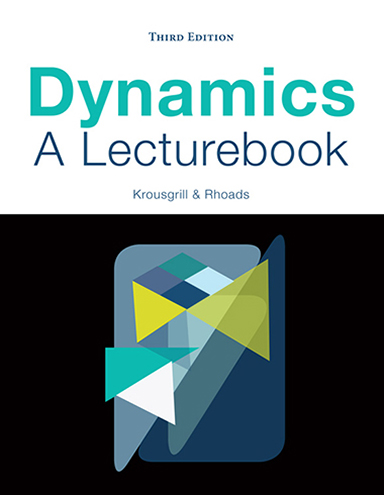Dynamics: A Lecturebook
by Charles M. Krousgrill and Jeffrey F. Rhoads
Fourth Edition
Print Version
Paperback Price: $100.93
ISBN: 978-1-50669-701-7
450 pages
Purchase
Availability: In Stock/Ready to Ship.
Suggested retail price shown above.
For discounted Bookstore or School District bulk orders: Contact Us

About the Book
This hybrid textbook/lecture notes set is designed to provide an undergraduate-level, engineering-focused introduction to the topic of dynamics. To this end, the text covers the following key topical areas:
• Particle and Rigid Body Kinematics, including Cartesian, path, polar, and cylindrical descriptions of motion; relative and constrained motion; vector kinematics; instantaneous centers of rotation; and 2D and 3D moving reference frames.
• Particle and Rigid Body Kinetics, including Newtons Laws of Motion; the work-energy equation; and the linear and angular impulse-momentum equations.
• Introduction to Mechanical Vibrations, including equation of motion development; free vibration response; harmonic forced vibrations; base excitation; and rotating imbalance, all as applied to single-degree-of-freedom systems.
The text provides pertinent background information, while emphasizing fundamental engineering principles, conceptual understanding, and optimal problem solving techniques. The Lecturebook also incorporates an extensive array of practical examples with which students can hone their skills.
Key distinctions between the Lecturebook and most conventional texts include:
• Complete integration of factual information and student-produced notes
• Removal of extraneous factual information
• The inclusion of conceptual problems designed to exercise higher levels of learning
• Lecture example, homework solution, and demonstration videos designed to aid asynchronous learning
The hybrid textbook/lecture note format provides most factual information in full, while brief and extended examples are provided with ample white space, allowing students to actively work the problems with the instructor's assistance in a classroom environment, or outside of the classroom on their own or with the assistance of online videos.
About the Author
Charles M. (Chuck) Krousgrill is a Professor in the School of Mechanical Engineering at Purdue University. He received his M.S. in mechanical engineering from Purdue University in 1975, and his M.S. and Ph.D. in applied mechanics from the California Institute of Technology in 1976 and 1980, respectively. During his more than 30 years at Purdue University, few, if any, individuals have had a greater impact on the university's undergraduate students and the institution's commitment to engineering education. Dr. Krousgrill's efforts in this regard have garnered numerous awards and international accolades. To date, these include the Purdue University School of Mechanical Engineering's Harry L. Solberg Best Teacher Award (seven times), the Purdue University College of Engineering's Potter Best Teacher Award (four times), the Purdue University Murphy Best Teacher Award, the 2010 Purdue University Helping Students Learn Award, the 2010 Purdue Alumni Association Special Boilermaker Award and the American Society of Engineering Education's 2011 Archie Higdon Distinguished Educator Award, the de facto lifetime achievement award for educational accomplishments in the field of mechanics. Outside of the classroom, Dr. Krousgrill conducts research in the general areas of dynamics and mechanical vibration.
Jeffrey F. (Jeff) Rhoads is an Associate Professor in the School of Mechanical Engineering at Purdue University and is affiliated with both the Birck Nanotechnology Center and Ray W. Herrick Laboratories at the same institution. He received his B.S., M.S., and Ph.D. degrees, each in mechanical engineering, from Michigan State University in 2002, 2004, and 2007, respectively. Dr. Rhoads is an active instructor in the areas of dynamics, mechanical vibration, and system modeling and analysis (linear and nonlinear). His current research interests include the predictive design, analysis, and implementation of resonant micro/nanoelectromechanical systems (MEMS/NEMS) for use in chemical and biological sensing, signal processing, and computing; the dynamics of parametrically-excited systems and coupled oscillators; and the behavior of mechanical systems operating in rich, multi-physics environments. Dr. Rhoads is a member of the American Society for Engineering Education (ASEE) and the American Society of Mechanical Engineers (ASME), where he serves on the Student Design Committee and the Design Engineering Division's Technical Committees on Micro/Nanosystems and Vibration and Sound. Dr. Rhoads is a 2009 recipient of the National Science Foundations Faculty Early Career Development (CAREER) Award, a 2011 recipient of the ASEE Mechanics Division's Ferdinand P. Beer and E. Russell Johnston, Jr. Outstanding New Mechanics Educator Award, and a two time recipient (2009, 2013) of the Purdue University School of Mechanical Engineering's Harry L. Solberg Best Teacher award.
Table of Contents
A Note to Students
A Note to Instructors
About the Authors
Chapter 0: Fundamentals and Review Material
Chapter 1: Particle Kinetics
Chapter2: Planar Rigid Body Kinematics
Chapter 3: Moving Reference Frame Kinematics
Chapter 4: Particle Kinetics
Chapter 5: Planar Rigid Body Kinetics
Chapter 6: Vibrations
